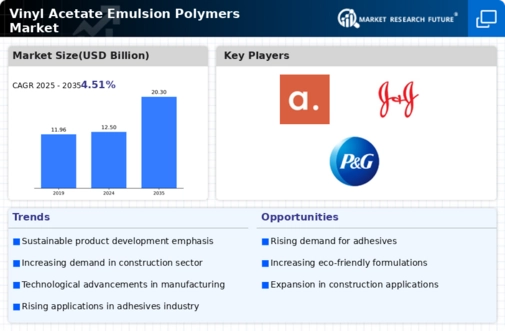Market Analysis
In-depth Analysis of Vinyl Acetate Emulsion Polymers Market Industry Landscape
The market dynamics of vinyl acetate emulsion polymers (VAE) reflect a blend of factors influencing the supply, demand, and trends within the industry. VAE polymers have gained prominence as versatile materials used in various applications, notably in adhesives, paints, and coatings. One of the primary drivers of the VAE market is the booming construction sector globally. The demand for environmentally friendly and sustainable building materials has led to an increased adoption of VAE polymers in the formulation of adhesives and construction chemicals, enhancing the overall performance and durability of these products.
Environmental regulations also play a pivotal role in shaping the dynamics of the VAE market. With a growing emphasis on reducing volatile organic compound (VOC) emissions, VAE polymers have become favored alternatives in the coatings industry. Their low VOC content aligns with stringent environmental standards, driving the market growth as manufacturers seek eco-friendly solutions to comply with regulations.
The evolving trends in the furniture and automotive industries contribute significantly to the dynamics of the VAE market. The demand for water-based adhesives, which often incorporate VAE polymers, is on the rise as these industries prioritize sustainability and seek alternatives to solvent-based adhesives. VAE polymers offer improved bonding strength and versatility, making them a preferred choice for various applications in these sectors.
Technological advancements in the production of VAE polymers also influence market dynamics. Ongoing research and development efforts focus on enhancing the performance characteristics of these polymers, such as their adhesion properties, flexibility, and durability. Innovations in formulation and manufacturing processes contribute to the competitiveness of VAE polymer products in the market, meeting the evolving needs of end-users.
Raw material prices and availability are crucial factors impacting the VAE market dynamics. The primary raw material, vinyl acetate monomer, is subject to fluctuations in pricing due to factors like feedstock costs and market demand. These variations can influence the overall production costs, subsequently affecting pricing strategies within the market. Additionally, supply chain disruptions and geopolitical events contribute to the complexity of raw material dynamics in the VAE market.
Competitive dynamics within the VAE market involve a mix of major multinational corporations and regional players. Companies engage in strategic initiatives such as mergers, acquisitions, and partnerships to strengthen their market position and expand their product portfolios. The pursuit of innovation and sustainability, coupled with a strong distribution network, forms the cornerstone of competitive strategies employed by market participants.
Geographically, the dynamics of the VAE market exhibit variations across regions. Developed economies with stringent environmental regulations, such as North America and Europe, witness a higher adoption of VAE polymers. In contrast, emerging economies in Asia-Pacific and Latin America experience robust growth due to increased construction activities, urbanization, and rising consumer awareness about sustainable materials.
Consumer preferences and awareness of sustainable practices are driving market dynamics, with end-users seeking products that align with eco-friendly principles. The shift towards water-based formulations, which often include VAE polymers, reflects the changing preferences of consumers who prioritize environmentally responsible choices.






Leave a Comment